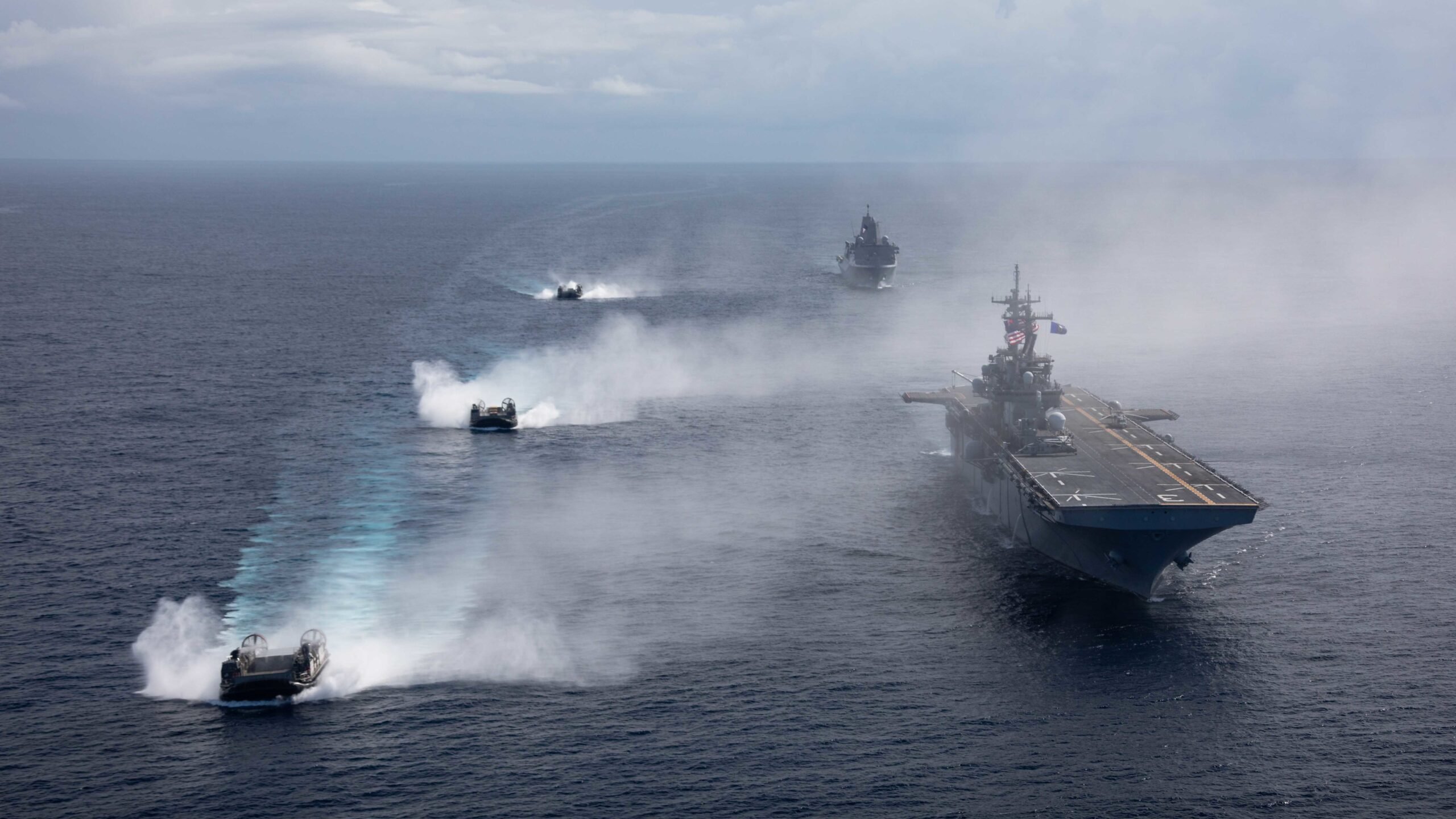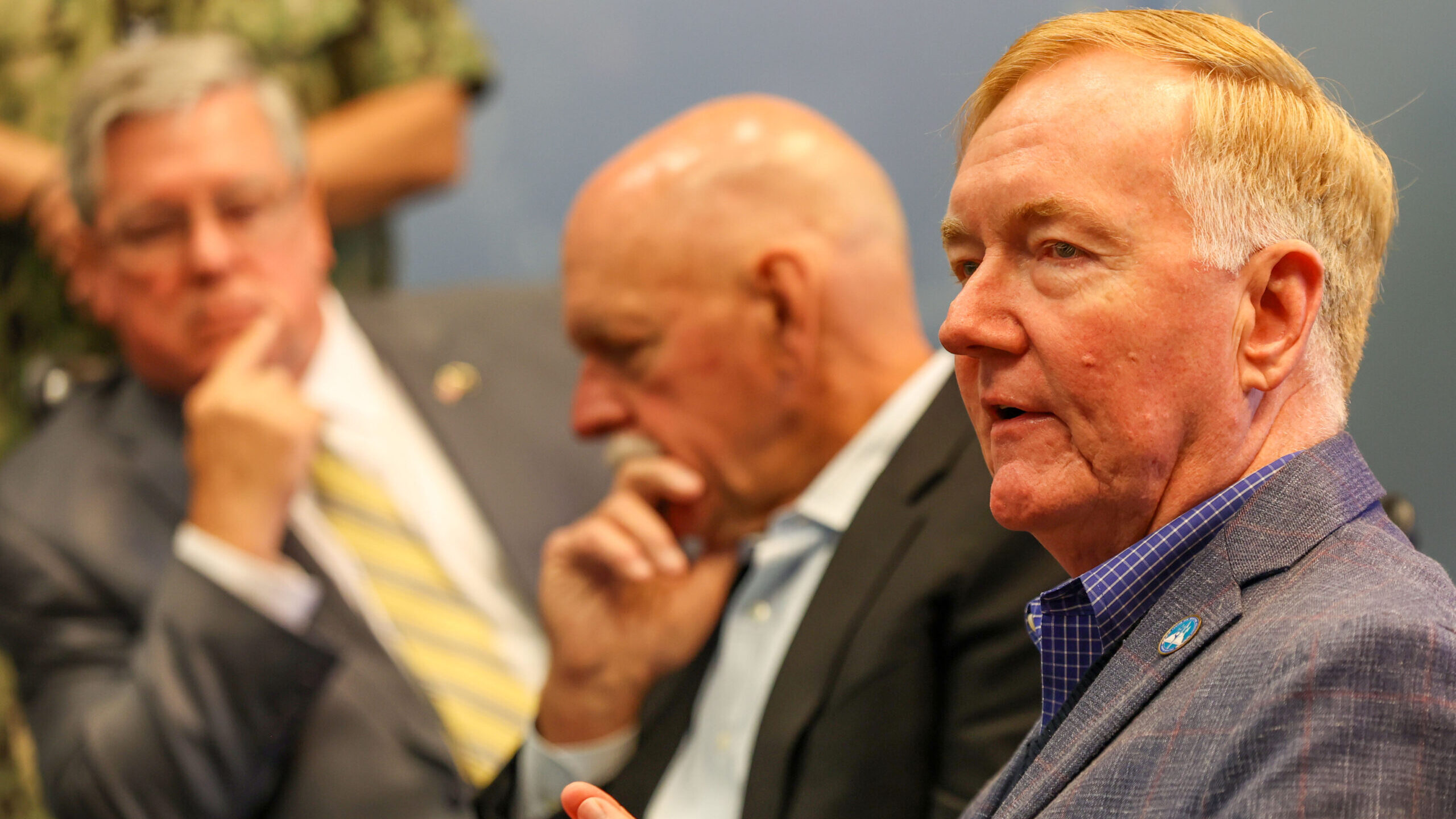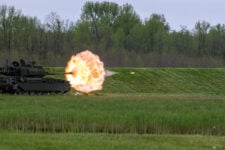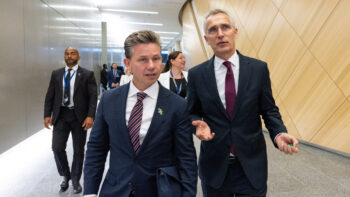
The amphibious assault ship Kearsarge (LHD 3), San Antonio-class amphibious transport dock ship Arlington (LPD 24), and various Landing Craft, Air Cushions sail in formation during Large Scale Exercise 2021. (U.S. Navy photo by Mass Communication Specialist 3rd Class Jesse Schwab)
Editor’s Note: This is the first in a series of stories about the US Navy and Marine Corps’ Large Scale Exercise 2023. The services provided Breaking Defense and other reporters an up close and personal look into how they are executing their biggest — and exclusively naval — training exercise.
NAVAL STATION NORFOLK, Va. — Inside a nondescript building at this southeastern Virginia naval base, dozens of sailors, officers, civilians and retired admirals roamed around a large room filled with computers and televisions.
Some of the monitors have been shut off — a concession to the arrival in the room of a few journalists, who moments ago were outside and staring at a sign above the entrance that warned that operations were happening on a “secret” classification level. Inside, signs atop some screens read out certain ship hulls or strike group numbers, partner and ally flags hung from the ceiling, and overseeing it all was Rear Adm. Andrew Burcher, vice commander of US Fleet Forces.
This room, he said, is the “nerve center” of Large Scale Exercise 2023, a global training event, which took place Aug. 9 to Aug. 18, pulling together more than 50 commands across 22 time zones, featuring thousands of sailors and Marines as well as dozens of warships and submarines, some real and some simulated.
While most military exercises often include other branches of the Pentagon or cooperation with foreign countries, LSE is a uniquely naval event testing whether the US Navy and Marine Corps are prepared for a global conflict using the technology and training they have today.
At the command level, the goal of Large Scale Exercise 2023 is meant to pressurize the Navy and Marine Corps’ leaders with what one admiral called “objective tension,” the innate dilemmas that are created for every Navy commodore and Marine Corps commanding officer when they have to accept that the fight happening elsewhere is going to impact the fight in front of them.
“When I say operational and tactical level, we’re talking from the 3- and 4-star fleet commander all the way down to the sailor or the Marine that is fighting with their weapon system,” said Capt. Chris Narducci, the exercise’s lead planner. The “sailor in the console, the Marine with his weapon. We’re stimulating that entire audience from the E-1 or E-2 up to the O-10 with this exercise.”
“It’s extremely infrequent,” Adm. Daryl Caudle, the commander of US Fleet Forces, said of working directly with both of his four-star counterparts in the European and Indo-Pacific theaters during an exercise such as LSE.
Adm. Samuel Paparo, who is currently leading US Pacific Fleet, is one of those two counterparts.
“The effect of simulating virtual units and virtual activity is to stress the command centers to get them up on a wartime footing,” he said, “so that we’re always ready and that the habits of mind and habits of action of commanding in a global threat environment, across a wide geography, across hundreds of units and 1,000s of warfighters, becomes ingrained in the key warfighting headquarters staff to train them.”
‘Injecting’ Problems, Virtually Teleporting Around The World
The precise details of the broader scenario that encompasses Large Scale Exercise were classified, according to the officials. Further, the staff said the envisioned adversary is not connected to any real individual country. Still, the Pentagon’s relentless focus on China, Russia, North Korea, Iran and violent extremism makes it easy to guess where certain simulated forces originate.
For example, Caudle, the officer directly responsible to the chief of naval operations for LSE’s success, told Breaking Defense in an interview that simulating Russian forces for part of the exercise brings “Arctic-type of thinking” into the event.
One of the ways commanders were tested during the exercise is through what’s known as “Live, Virtual and Constructive” training. LVC is akin to a massive video game. While real sailors and Marines operate in the field or aboard their vessels, the exercise’s staff can “inject” a variety of scenarios and problems into the operations, simulating what could happen if a real global conflict broke out, the planners said.
A ship’s commanding officer might be told an adversarial spy plane is patrolling overhead. A fleet commander ashore who requests an asset be deployed might be denied because those capabilities are tied up in operations elsewhere.
A crew might be physically docked in Norfolk, Va., but modern training technology can effectively teleport them to the Mediterranean where their consoles and maps will show other units and assets in the area — whether those units are physically present or also simulated, the crew would be none the wiser. (This is easier to accept if you remember that when sitting in the bowels of an aircraft carrier, there are no windows to let you see the Atlantic Ocean just a stone’s throw away and you are relying on monitors regularly.)
The possibilities are only limited by what the exercise staff can think up, with the goal of creatively stress testing the system and discovering failures.
And the exercise’s leaders say they have close to 1,000 personnel helping them do just that. Among those staff were a handful of retired admirals and generals — referred to as “graybeards” — tasked with using their experience to role play joint force commanders or civilian leadership such as the secretary of defense.

James Foggo (front) and Scott Swift (center) are both retired Navy admirals participating in the service’s Large Scale Exercise 2023 as “graybeards.” (U.S. Navy photo by Chief Mass Communication Specialist Theodore Green)
For instance, one of these guests “plays the role of the [US European Command] commander and… that is a forcing function for Adm. [Stuart] Munsch,” Scott Swift, a retired Navy admiral and one of the graybeards in attendance, told reporters, referring to the current admiral commanding US Naval Forces Europe and Africa. “For the tactical units… [the retired general] makes things hard on Adm. Munsch in a realistic way.
“Because we have the role-players, it’s as close — I think it’s exactly like [the] real world,” Swift added.
James Foggo, the retired Navy admiral who once held Munsch’s current job, was also in attendance and played the role of the chairman of the joint chiefs. He described balancing the need for assets and the joint staff’s ability to provide them to the component commanders as the “healthy tension” necessary to make LSE a realistic scenario.
“We have a limited number of things, ships, aircraft [and] people. There’s going to be tugging and pulling as the scenario progresses,” he said. “Somebody has got to sit back in Washington and balance that out and say, ‘Well, I can’t give you more of that.’”
3 Commanders, 2 Services Left Out, 1 Big Exercise
While the nerve center hummed along, elsewhere on the naval base, three of the Navy’s most senior officers gathered via teleconference for a “global maritime commander synchronization meeting.”
The US Navy has only six billets consistently filled by four-star admirals and three of those six officers were in this meeting: Caudle, the US Fleet Forces chief; Munsch, commander of US Naval Forces Europe and Africa; and Paparo, who in addition to leading the Pacific Fleet is currently nominated to follow in his boss’ footsteps as the next US Indo-Pacific Command chief. (While there are other four-star admirals on active duty, their billets are all subject to be rotated to the other services at the White House’s discretion.)
In a rare joint press conference, all three admirals described the unique and challenging nature of having three of the most senior operational commanders coordinating their forces for a single event. The challenges start with just finding agreeable times to talk, Caudle said, noting that in Hawaii where Paparo is based, it was around eight o’clock in the morning, while Munsch, based in Naples, Italy, was working well past rush hour, speaking to the press at roughly 10 pm.
As to the scenario, Paparo and Munsch stressed the need for the “friction” that Swift, Foggo, the other graybeards and the hundreds of staff injecting problems into the scenario were trying to create. Munsch, whose previous tours include billets on the joint staff, said the Pentagon conducts other exercises that are as globally reaching as LSE, but remain mostly virtual “so there’s an element of friction that’s missing.” Conversely, there are other global joint exercises that use real forces, but the event is spread over a longer period, and so they lack intensity.
“What makes this event unique is that we have both the friction of real forces as well as the scale that virtual forces offer. And it’s all in a very intense period,” Munsch said.
Asked about why the Navy doesn’t include the Army or Air Force and their leaders in what is supposed to be a “global” exercise, Caudle conceded that in an ideal world he would invite the sister services to join in. The problem, he said, is that the larger the exercise grows, the more difficult it becomes to balance everyone’s schedules and ability to participate. Attempting to recruit the broader joint force into an already massive event could become so unwieldy that the exercise simply would not happen, he said.
All the meanwhile, none of the three commanders were off the hook from their usual duties. In Munsch’s area of responsibility, US European Command continues to monitor the ongoing war between Russia and Ukraine. And in the Indo-Pacific, Paparo oversees forces that are being challenged by China daily.
This kind of event is “taxing,” said Caudle. “And so, they’ve [Paparo and Munsch] devoted this level of time and effort with their staffs because of the understanding we need to be able to have this same sight picture and to actually work together at this level… Against a peer competitor that we’re talking about, all the fights are going to be global.”






















